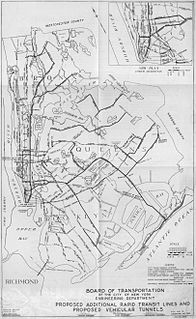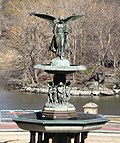
The Q Second Avenue/Broadway Express/Brighton Local is a rapid transit service in the B Division of the New York City Subway. Its route emblem, or "bullet", is colored yellow since it uses the BMT Broadway Line in Manhattan.

The Independent Subway System, formerly known as the Independent City-Owned Subway System (ICOSS) or the Independent City-Owned Rapid Transit Railroad (ICORTR), was a rapid transit rail system in New York City that is now part of the New York City Subway. It was first constructed as the Eighth Avenue Line in Manhattan in 1932.

Since the opening of the original New York City Subway line in 1904, and throughout the subway's history, various official and planning agencies have proposed numerous extensions to the subway system. The first major expansion of the subway system was the Dual Contracts, a set of agreements between the City of New York and the IRT and the BRT. The system was expanded into the outer reaches of the Bronx, Brooklyn, and Queens, and it provided for the construction of important lines in Manhattan. This one expansion of the system provided for a majority of today's system.

New York City Subway nomenclature is the terminology used in the New York City Subway system as derived from railroading practice, historical origins of the system, and engineering, publicity, and legal usage. Important terms include lines, or individual sections of subway, like the BMT Brighton Line; services, like the B, which is a single train route along several lines; and stations, such as Coney Island–Stillwell Avenue, which connects multiple lines and services.
The BMT Broadway Line is a rapid transit line of the B Division of the New York City Subway in Manhattan, New York City, United States. As of November 2016, it is served by four services, all colored yellow: the N and Q trains on the express tracks and the R and W trains on the local tracks during weekdays. The line is often referred to as the "N and R", since those were the only services on the line from 1988 to 2001, when the Manhattan Bridge's southern tracks were closed for rebuilding. The Broadway Line was built to give the Brooklyn Rapid Transit Company access to Midtown Manhattan.
The IND Sixth Avenue Line is a rapid transit line of the B Division of the New York City Subway in the United States. It runs mainly under Sixth Avenue in Manhattan, and continues south to Brooklyn. The B, D, F, and M trains, which use the Sixth Avenue Line through Midtown Manhattan, are colored orange. The B and D trains use the express tracks, while the F, <F> and M trains use the local tracks.

The New York City Subway is a rapid transit system that serves four of the five boroughs of New York City, New York: the Bronx, Brooklyn, Manhattan, and Queens. Its operator is the New York City Transit Authority (NYCTA), which is controlled by the Metropolitan Transportation Authority (MTA) of New York. In 2016, an average of 5.66 million passengers used the system daily, making it the busiest rapid transit system in the United States and the seventh busiest in the world.
The IND 63rd Street Line and BMT 63rd Street Line, also referred to as the 63rd Street Crosstown, Crosstown Route, or Route 131-A, are two rapid transit lines of the IND and BMT divisions of the New York City Subway system. The two lines run under 63rd Street in the Upper East Side of Manhattan, with a cross-platform interchange at the Lexington Avenue–63rd Street station.

Seventh Avenue is a station on the IND Sixth Avenue Line and the IND Queens Boulevard Line of the New York City Subway. Located at the intersection of Seventh Avenue and 53rd Street in Manhattan, it is served by the D and E trains at all times, and the B train weekdays. The station is announced as Seventh Avenue–53rd Street, in the style of other stations that orient east-west along 53rd Street, as well as to prevent confusion with Seventh Avenue along the BMT Brighton Line in Brooklyn, which is also served by the B.

The Uptown Hudson Tubes are a pair of tunnels that carry PATH trains between Manhattan, New York City, to the east and Jersey City, New Jersey, to the west. The tubes originate at a junction of two PATH lines on the New Jersey shore and cross eastward under the Hudson River. On the Manhattan side, the tubes run mostly underneath Christopher Street and Sixth Avenue, making four intermediate stops before terminating at 33rd Street station. Despite their name, the tubes do not enter Uptown Manhattan, but are so named because they are located to the north of the Downtown Hudson Tubes, which connect Jersey City and the World Trade Center.

Lexington Avenue–63rd Street is a New York City Subway station in Lenox Hill, Manhattan, shared by the IND and BMT 63rd Street Lines. Located at the intersection of Lexington Avenue and 63rd Street, it is served by the:
Marc André Edmonds, also known by the graffiti name ALI and as J. Walter Negro, “The Playin’ Brown Rapper” was an American artist and musician. As ALI, he is best known as the founder of 'Soul Artists' and originator of the cult of Zoo York. As "alter-ego" J. Walter Negro, he is remembered as the lead singer/songwriter of the proto-hip-hop-rap group 'J. Walter Negro and the Loose Jointz', who had some success with their 1981 release "Shoot the Pump".
References to the New York City Subway in popular culture are prevalent, as it is a common element in many New Yorkers' lives.
The New York City Subway's B Division consists of the lines that operate with lettered services, as well as the Franklin Avenue and Rockaway Park Shuttles. These lines and services were operated by the Brooklyn–Manhattan Transit Corporation (BMT) and city-owned Independent Subway System (IND) before the 1940 city takeover of the BMT. B Division rolling stock is wider, longer, and heavier than those of the A Division, measuring 10 or 9.75 ft by 60 or 75 ft.

Jay Street–MetroTech is a New York City Subway station complex on the IND Fulton Street, IND Culver, and BMT Fourth Avenue lines. The complex is located in the vicinity of MetroTech Center in Downtown Brooklyn. It is served by the:












